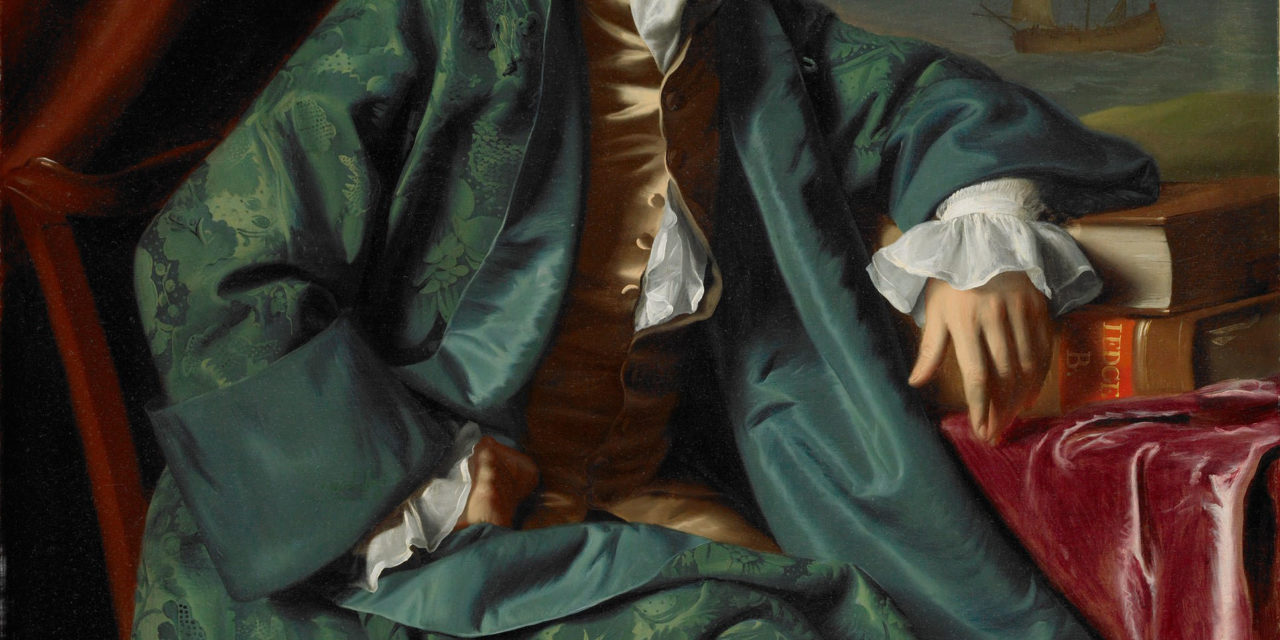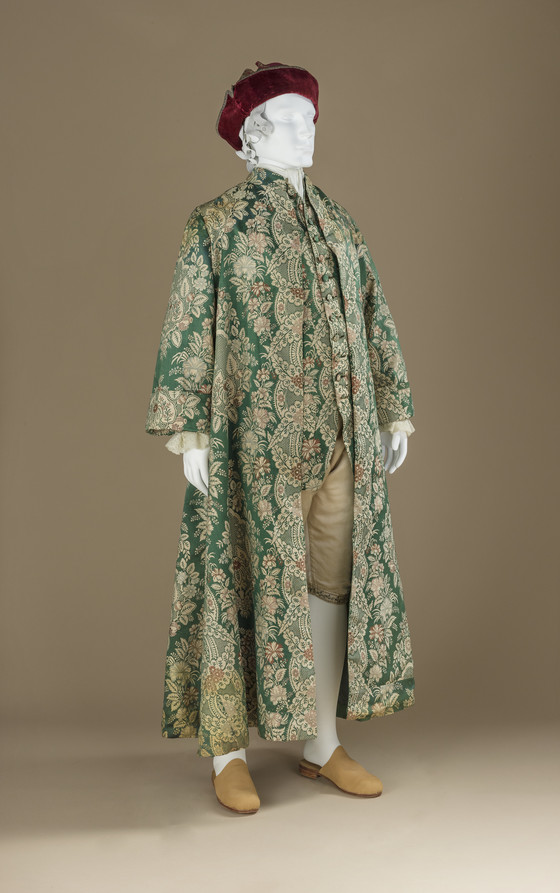A banyan is a loose-fitted informal robe or gown typically worn by men in the late 17th to the early 19th centuries.
The Details
In The Fairchild Books Dictionary of Fashion (2014), Phyllis G. Tortora offers a definition of the banyan:
“Comfortable, loose-fitted dressing gown worn by men in the late 17th through the early 19th c. Often very decorative, these garments were made from a wide variety of fabrics, including cotton calicos, elaborate silks, and glazed wool. Although this garment was made for indoor wear, it was not unheard of for a man to go outside in his banyan. Derived from banian, a caste of Hindu merchants from the subcontinent of India. Also spelled banian, banjan.” (24)
In Fashion and Orientalism: Dress, Textiles and Culture from the 17th to the 21st Century (2013), Adam Geczy discussed the banyan’s appearance in the 18th century as part of larger orientalist trends:
“By the middle of the eighteenth century, orientalist costume and dress was, among other things, an outward sign of an expanded and freewheeling consciousness. It coalesced into one single item, the banyan, or banian, the paragon of male informal dress resulting in the robe de chambre, English morning dress, and the smoking jacket. By the middle of the eighteenth century it was an important hallmark of intellectual manhood.”
The Metropolitan Museum of Art explains this further in describing a group of banyans in their collection (Fig. 1), writing, “In England these dressing gown were called ‘banyans’ or ‘Indian nightgown’ because of their kimono-like form and Eastern origin.”
The banyan was typically man’s robe or gown, as you can see in figure 2, which is a French example from the 1720s.
Banyans were occasionally worn by women; the Victoria and Albert Museum in London has a more tailored green women’s silk banyan, which was created from 1740 to 1760 (Fig. 3), in its collection.
Tortora and Eubank write in Survey of Historic Costume: A History of Western Dress (2010) about different types of banyans:
“Comfortable loosely fitted garments variously known as nightgowns, morning gowns, dressing gowns, Indian gowns, or banyans (ban’-yan) were worn throughout the century as casual or undress at home. Cunningham in a detailed study identifies several variations. A loose, full kimono style was more widely worn in the early part of the century. Another type was more form fitting, similar to a man’s coat, with set-in sleeves. Each of these basic styles could have additional variations (Cunningham 1984). Fabrics preferred for banyans included cotton calicos; silk damasks, brocades, velvets, taffetas, or satins; and wool worsteds and calamancos (glazed wool worsted fabric with raised stripes of the same color).” (275)
The Fashion Dictionary (1975) by Mary Brooks Picken describes the banyan’s use in America:
“Loose wrap, usually brightly colored, sometimes lined so as to be worn either side out. Worn in 18th century in America, especially by Southern planters, as informal or negligee costume.” (379)
A painting by John Singleton Copley (Fig. 4) in 1767 shows Nicholas Boylston wearing green banyan and a cap.
The banyan rose to prominence in Europe in the eighteenth century due to trade with Asia and became a symbol of wealth and sophistication for men who could afford luxurious textiles and leisurewear.
Fig. 1 - Makers unknown. Banyans, second half 18th century. Silk, wool, linen. New York: The Metropolitan Museum of Art, C.I.56.5.1a–c. Purchase, Irene Lewisohn Bequest, 1956. Source: The Met
Fig. 2 - Maker unknown (French). At-home Robe (Banyan) with Matching Waistcoat, 1720s. Silk satin with silk supplementary-weft patterning bound in twill (lampas). Los Angeles County Museum of Art, M.2010.90a-b. Costume Council Fund. Source: LACMA
Fig. 1 - Anna Maria Garthwaite (English, 1690-1763). Banyan, 1740-1750 (woven), 1750-1760 (made). Silk damask, lined with silk taffeta and linen, hand-sewn with silk and linen thread. London: Victoria & Albert Museum, T.92-2003. Source: V&A
Fig. 4 - John Singleton Copley (American, 1738-1815). Nicholas Boylston (1716-1771), 1767. Oil on canvas; 127.3 x 101.1 cm (50 1/8 x 39 13/16 in). Cambridge: The Harvard Art Museums, H90. Source: Harvard
References:
- “Banyan, ca 1780.” The Metropolitan Museum of Art. https://www.metmuseum.org/art/collection/search/87231
- Geczy, Adam. “1690–1815: Chinoiserie, Indiennerie, Turquerie and Egyptomania.” In Fashion and Orientalism: Dress, Textiles and Culture from the 17th to the 21st Century, 41–84. London: Bloomsbury Academic, 2013. http://dx.doi.org/10.2752/9781474235280/Geczy0004.
- Picken, Mary Brooks. The Fashion Dictionary: Fabric, Sewing, and Apparel as Expressed in the Language of Fashion. New York: Funk & Wagnalls, 1973. http://www.worldcat.org/oclc/572308967
- Tortora, Phyllis G., and Sandra J. Keiser. The Fairchild Books Dictionary of Fashion. New York: Fairchild Books, 2014. http://www.worldcat.org/oclc/900349357
- Tortora, Phyllis G. & Keith Eubank. Survey of Historic Costume: A History of Western Dress, 5th ed. New York: Fairchild Books, 2010. http://www.worldcat.org/oclc/1158798865














